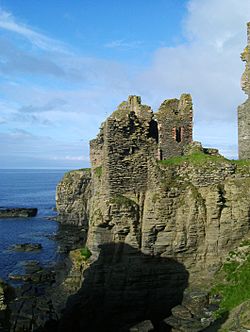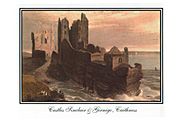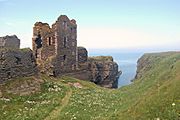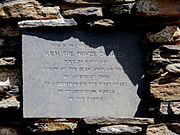Castle Sinclair Girnigoe facts for kids
Quick facts for kids Castle Sinclair Girnigoe |
|
|---|---|
| Wick, Caithness, Scotland | |

Castle Sinclair Girnigoe from Sinclair's Bay
|
|
| Coordinates | 58°28′41″N 3°04′05″W / 58.478014°N 3.068082°W |
| Type | L-plan tower house with numerous extensions |
| Site information | |
| Owner | the Sinclair Castle Trust |
| Open to the public |
Yes |
| Condition | Ruin |
| Site history | |
| Built | between 1476 and 1496 |
| Built by | William Sinclair, 2nd Earl of Caithness |
| In use | 15th century to 17th century |
| Materials | Stone |
Castle Sinclair Girnigoe is an amazing old castle ruin in Scotland. It's found on the east coast of Caithness, about 3 miles north of Wick. This special place is actually two castles in one! There's the older Castle Girnigoe from the 1400s and the newer Castle Sinclair from the early 1600s. Together, they are a protected historical site called a scheduled monument. It was one of the first main homes for Clan Sinclair.
Contents
A Look Back: The Castle's Story
Building the Castle
The first part, Castle Girnigoe, was built by William Sinclair, 2nd Earl of Caithness. This was likely between 1476 and 1496. He died in 1513 at the Battle of Flodden. Some clues suggest the castle was built on top of an even older fort.
In 1577, George Sinclair, 4th Earl of Caithness, held his own son, John Sinclair, Master of Caithness, captive at Castle Girnigoe. He was kept there for seven years. Sadly, he later died while still imprisoned.
Changes and Challenges
The castle grew in 1606 when Castle Sinclair was added. This included a gatehouse and other buildings. A strong curtain wall was also built. These new parts connected to the older castle with a drawbridge over a deep ditch.
That same year, George Sinclair, 5th Earl of Caithness, asked the Scottish Parliament to change the name to Castle Sinclair. However, both names were still used in 1700. So, people have called it both Castle Sinclair and Castle Girnigoe ever since.
Castle Girnigoe was a five-story L-plan tower house. It had a special crow-stepped roof. The castle sat on a rocky point reaching out into Sinclair Bay. It even had a secret room hidden in the kitchen's arched ceiling!
In 1672, George Sinclair, 6th Earl of Caithness, owed a lot of money to John Campbell. So, he gave the castle to Campbell as payment. When Sinclair died without children, Campbell tried to claim the title of Earl of Caithness. He even married Sinclair's widow.
However, Sinclair's cousin, George Sinclair of Keiss, disagreed. This led to a fight called the Battle of Altimarlach in 1680. Campbell won this battle. After the battle, George Sinclair of Keiss fought back. He attacked Castle Sinclair Girnigoe and took it over. Eventually, through legal efforts, George Sinclair of Keiss became the 7th Earl of Caithness in 1681. His lands, including the castle, were given back to him.
Keeping the Castle Safe
Since 1998, the Clan Sinclair Trust has been working hard to study and protect the castle. They are doing archaeological research there. Castle Sinclair Girnigoe is the only castle in Scotland listed by the World Monuments Fund. This shows how important it is!
Images for kids
-
Plaque showing the Prince Charles, Duke of Rothesay as patron of the Clan Sinclair Trust






